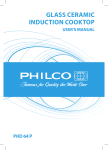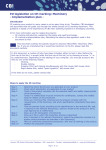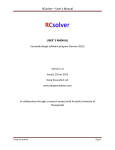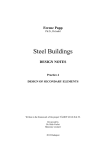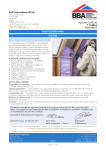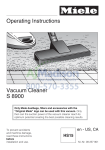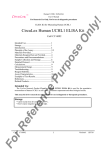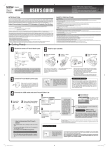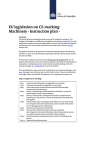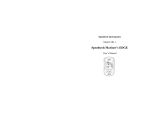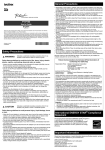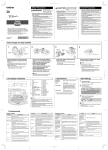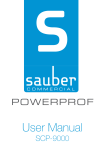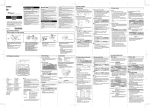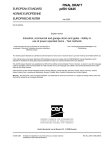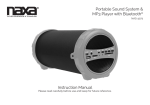Download EU legislation on CE-marking - Trade Development Authority Of
Transcript
EU legislation on CE-marking: Electromagnetic Compatibility (EMC) - Instruction plan Summary The CE marking (also known as CE mark) is a mandatory conformity mark on many products placed on the single market in the European Economic Area (EEA). The CE marking does not certify that a product has met EU consumer safety, health or environmental requirements. CE marking might be difficult but obligatory to apply on certain products. This guidance is based on the experiences of CBI when assisting exporters in developing countries. So, if you are manufacturing or exporting products related to electromagnetic compatibility to the EU, please read this document carefully. This document outlines the specific issues for Directive 2004/108/EC `Electromagnetic Compatibility` (EMC). This Directive sets requirements for the electromagnetic emissions of electrical and electronic equipment and their immunity to interference. This directive has not been changed recently. The information has undergone editorial changes only. The guidance for this directive has been updated. See the Guide for the EMC Directive 2004/108/EC. Steps to apply the CE-marking Step 1 Step 2 Step 3 Step 4 Step 5 Determine which Directive(s) are applicable to your product Check which standard(s) are applicable to your product Check if the product complies with the essential health and safety requirements of the Directive(s) Check if a notified body must be involved for certification, contact the notified body for details on the procedures Draw up a Technical File, showing how the product complies with the requirements of the Directives, and which specifications (standards) have been applied Step 6 Test the product (type) according to the specifications in the technical file, and, if required in the relevant Directive(s), submit a model of the product to an EC type approval by a notified body Step 7 Draw up an EC Declaration of Conformity Step 8 Draw up a file in which the production process is described and, if required in the relevant Directive(s), submit the production process to a quality control procedure as describes in the Directive(s) Step 9 After all conformity assessment procedures: affix the CE-marking to the product Step 10 Monitor the production process Step 1 - Determine which Directive(s) are applicable to your product 1.1 The revised EMC Directive (introduction) Find out which Directive applies to your product. This is done by looking at the scope of the Directive, which is described in its text. Please note that more than one Directive might be applicable to your product. The EMC Directive applies to apparatus liable to cause electromagnetic disturbance or the performance of which is liable to be affected by such disturbance. In other words: it governs the electromagnetic emissions of electrical and electronic equipment and their immunity to interference. It ensures for instance that a microwave oven does not interfere with radio EU legislation on CE-marking: Electromagnetic Compatibility (EMC) – Instruction plan reception, or that a radio alarm clock must not come on if a mobile phone is used nearby. The latest version of the directive can be found here. The main objective of the EMC Directive is to regulate the compatibility of equipment regarding EMC. In order to achieve this objective, provisions have been put in place so that: equipment (apparatus and fixed installations) needs to comply with the requirements of the EMC Directive when it is placed on the market and/or taken into service; the application of good engineering practice is required for fixed installations, with the possibility for the competent authorities of Member States to impose measures if non-compliances are established. The main elements of the revised Directive are: Simplified conformity procedures, reducing costs for manufacturers Stricter requirements concerning information and documentation. The new Directive requires manufacturers or their agents to provide inspection authorities with additional means of control, such as clear identification of a product (type, serial number, etc) and indication of the name and address of the manufacturer or his agent and, if necessary, of the importer established in the EU. This improved product traceability will make it easier for the authorities to monitor the market. By eliminating products for which it is difficult at the moment to identify the origin, competition will be on a fairer basis. Special regime for fixed installations. It is harder to check the conformity of installations of this type (changes over time, alterations, difficulties in implementation). However, it is essential that they comply with the Directive's protection requirements in order to limit potential interference and to create a common electromagnetic environment in the European Union. The revised Directive abolishes two cumbersome conformity assessment procedures for producers who required the mandatory involvement of an independent inspection and verification body, thus reducing costs. Manufacturers will be solely responsible for establishing the conformity of their products and for the CE marking. Please note that a product may be subject to more than one Directive. For example, the Machinery Directive, the Low Voltage Directive (LVD) and the Directive on Electromagnetic Compatibility (EMC) may be applicable at the same time. If the apparatus (device) contains pressure equipment, the Pressure Equipment Directive (PED) may be relevant, and if the apparatus is designed for use in a potentially explosive atmosphere, the ATEX Directive requirements must be observed. See the separate documents on the various Directives mentioned. To establish the relevance of the other Directives, see step 1 in each of the Directives described. Directives that possibly apply as well Directive 98/37/EEC 73/23/EEC (as amended) 97/23/EC (as amended) 94/9/EC Title Machinery Low Voltage Pressure Equipment Equipment and protective systems intended for use in potentially explosive atmospheres Abbreviation MD LVD PED ATEX EU legislation on CE-marking: Electromagnetic Compatibility (EMC) – Instruction plan Please note that a full list of Directives is shown in the related document CE marking implementation plan. This includes a table with arrows, which are links to websites showing Directives, information about Directives, development of standards, and a list of harmonised standards in relation to the Directive concerned. The EU has a guide available to assist with implementing the Directive. It has no weight in law, but deals with a number of practical issues that will be of interest to manufacturers. See the Guide for the EMC Directive 2004/108/EC 1.2 Entry into force In 2004, the new Directive for EMC has been adopted and by 20 July 2007 it entered into force in the EU Member States. However, products that comply with the ‘old’ Directive 89/336/EEC will be allowed on the market until 20 July 2009. 1.3 Definitions of the EMC Directive (article 1) For the purposes of the EMC Directive the following definitions are important: Equipment means any apparatus or fixed installation. Apparatus means any finished appliance or combination thereof made commercially available as a single functional unit, intended for the end user and liable to generate electromagnetic disturbance, or the performance of which is liable to be affected by such disturbance. Fixed installation means a particular combination of several types of apparatus and, where applicable, other devices, which are assembled, installed and intended to be used permanently at a predefined location. Electromagnetic compatibility means the ability of equipment to function satisfactorily in its electromagnetic environment without introducing intolerable electromagnetic disturbances to other equipment in that environment. Electromagnetic disturbance means any electromagnetic phenomenon which may degrade the performance of equipment. An electromagnetic disturbance may be electromagnetic noise, an unwanted signal, or a change in the propagation medium itself. Immunity means the ability of equipment to perform as intended without degradation in the presence of an electromagnetic disturbance. Safety purposes means the purposes of safeguarding human life or property. Electromagnetic environment means all electromagnetic phenomena observable in a given location. 1.4 Scope, exclusions and applicability The EMC Directive regulates the electromagnetic compatibility of equipment. It aims to ensure the functioning of the internal market by requiring equipment to comply with an adequate level of electromagnetic compatibility. The EMC Directive defines that certain apparatus have been excluded from the scope of the Directive: a) Equipment covered by Directive 1999/5/EC “Radio Equipment and Telecommunications Terminal Equipment and the Mutual Recognition of their Conformity”. EU legislation on CE-marking: Electromagnetic Compatibility (EMC) – Instruction plan b) Aeronautical products, parts and appliances as referred to in Regulation (EC) No. 1592/2002 of the European Parliament and of the Council of 15 July 2002 on common rules in the field of civil aviation and establishing a European Aviation Safety Agency. Step 2 - Check which standard(s) are applicable to your product For compliance with the Directives that apply to your product, standards give detailed technical information on implementing the EU requirements. However, not all standards have been harmonised yet. Only standards that have their reference published in the Official Journal of the EU are called ‘harmonised standards’. Complying with these standards means that the authorities presume compliance with the Directives. This step of checking the relevant standards – whether or not harmonised – is crucial for CE-marking. 2.1 How to find harmonised standards The EU gives on its own site a summarised list of harmonised standards, published in the Official Journal. See: harmonized standards. 2.2 Other standards and draft standards More standards are under development. An overview of standardization activities is given here. Step 3 - Check if the product complies with the essential health and safety requirements of the Directive Apply the relevant standards for the performance requirements in the Directives or the technical verification, and, where appropriate, a risk assessment. Please note that the user documentation (see step 7 on installation, operating manual, maintenance instructions, etc.) is an integral part of the product and needs to be assessed together with the product. Essential requirements (Article 5 of the Directive and Annex I): 1. Protection requirements Equipment shall be so designed and manufactured, having regard to the state of the art, as to ensure that: (a) The electromagnetic disturbance generated does not exceed the level above which radio and telecommunications equipment or other equipment cannot operate as intended; (b) It has a level of immunity to the electromagnetic disturbance to be expected in its intended use which allows it to operate without unacceptable degradation of its intended use. 2. Specific requirements for fixed installations Installation and intended use of components. A fixed installation shall be installed applying good engineering practices and respecting the information on the intended use of its components, with a view to meeting the protection requirements set out in Point 1. Those good engineering practices shall be documented and the documentation shall be held by the person(s) responsible at the disposal of the relevant national authorities for inspection purposes for as long as the fixed installation is in operation. All apparatus must be accompanied by instructions containing all the information required in order to use the apparatus in accordance with the intended purpose and in the defined EU legislation on CE-marking: Electromagnetic Compatibility (EMC) – Instruction plan electromagnetic environment. Other than to facilitate the operation of the apparatus, their purpose is to ensure that no EMC problem is encountered in use. These instructions must give the following information (article 9): 1. Each apparatus shall be identified in terms of type, batch, serial number, or any other information allowing for the identification of the apparatus. 2. Each apparatus shall be accompanied by the name and address of the manufacturer and, if he is not established within the EU, the name and address of his authorised representative or of the person in the EU responsible for placing the apparatus on the EU market. 3. The manufacturer shall provide information on any specific precautions that must be taken when the apparatus is assembled, installed, maintained or used, in order to ensure that, when put into service, the apparatus is in conformity with the protection requirements set out in Annex I, point 1 (Protection requirements, see above). 4. Apparatus for which compliance with the protection requirements is not ensured in residential areas shall be accompanied by a clear indication of this restriction of use, where appropriate also on the packaging. 5. The information required to enable apparatus to be used in accordance with the intended purpose of the apparatus shall be contained in the instructions accompanying the apparatus. Step 4 - Check if a notified body must be involved for certification Contact a notified body, if so desired, for details on the procedures for conformity assessment. It depends on the Directive(s) involved if a notified body must be involved for certification of the product and the production process. For the present EMC Directive, this is not required. A notified body may be involved at the choice of the manufacturer to assess the technical file (article 7, and Annex III). Please note that: The Low Voltage Directive usually applies as well. A notified body may be consulted on a voluntary basis for equipment covered by the Low Voltage Directive and most equipment and components covered by the Machinery Directive (except for equipment described in Annex IV of the Machinery Directive). 10 practical tips on how to select a notified body are given in the related document explaining the step by step approach followed in this document, i.e. the document CE marking instruction plan. EU legislation on CE-marking: Electromagnetic Compatibility (EMC) – Instruction plan Step 5 - Draw up a Technical File, showing how the product complies with the requirements of the Directives, and which specifications (standards) have been applied The technical file should contain the documentation on how the conformity has been achieved. If the Directive requires a verification of the file, for example when the product has to be submitted to an EC type approval, this file will be checked together with the product or separately. Besides general information like name and address of the manufacturer, identification of the product, drawings and overviews of the product, all relevant detailed information on the design, construction and testing, risk assessment, certificates, applied standards, a description of the preventive measures and a copy of the user manual must be included. For this Directive the technical documentation consists of: User information (article 9) Internal production control, in which the production process is described to ensure compliance with the Directive (Annex II). Technical documentation (Annex IV) User information See step 3. Internal production control (Conformity assessment procedure referred to in article 7, described in Annex II): 1. The manufacturer shall perform an electromagnetic compatibility assessment of the apparatus, on the basis of the relevant phenomena, with a view to meeting the protection requirements set out in Annex I, point 1. The correct application of all the relevant harmonised standards shall be equivalent to the carrying out of the electromagnetic compatibility assessment. 2. The electromagnetic compatibility assessment shall take into account all normal intended operating conditions. Where the apparatus is capable of taking different configurations, the electromagnetic compatibility assessment shall confirm whether the apparatus meets the protection requirements set out in Annex I, point 1, in all the possible configurations identified by the manufacturer as representative of its intended use. 3. In accordance with the provisions set out in Annex IV, the manufacturer shall draw up technical documentation providing evidence of the conformity of the apparatus with the essential requirements of this Directive. 4. The manufacturer or his authorised representative in the EU shall hold the technical documentation at the disposal of the competent authorities for at least ten years after the date on which such apparatus was last manufactured. 5. The compliance of apparatus with all relevant essential requirements shall be attested by an EC declaration of conformity issued by the manufacturer or his authorised representative in the EU. 6. The manufacturer or his authorised representative in the EU shall hold the EC declaration of conformity at the disposal of the competent authorities for a period of at least ten years after the date on which such apparatus was last manufactured. 7. If neither the manufacturer nor his authorised representative is established within the EU, the obligation to hold the EC declaration of conformity and the technical documentation at the disposal of the competent authorities shall lie with the person who places the apparatus on the EU market. EU legislation on CE-marking: Electromagnetic Compatibility (EMC) – Instruction plan 8. 9. The manufacturer must take all measures necessary to ensure that the products are manufactured in accordance with the technical documentation referred to in point 3 and with the provisions of this Directive that apply to them. The technical documentation and the EC declaration of conformity shall be drawn up in accordance with the provisions set out in Annex IV. Technical documentation Technical documentation (Annex IV) must enable the conformity of the apparatus with the essential requirements to be assessed. It must cover the design and manufacture of the apparatus, in particular: a general description of the apparatus; evidence of compliance with the harmonised standards, if any, applied in full or in part; where the manufacturer has not applied harmonised standards, or has applied them only in part, a description and explanation of the steps taken to meet the essential requirements of the Directive, including a description of the electromagnetic compatibility assessment set out in Annex II, point 1, results of design calculations made, examinations carried out, test reports, etc.; a statement from the notified body, when the procedure referred to in Annex III has been followed. Step 6 – Test the product (type) according to the specifications in the technical file, and, if required in the relevant Directive(s), submit a model of the product to an EC type approval by a notified body All testing carried out by the manufacturer, a laboratory, test house or notified body, will be included in the technical file. Since it is not always possible or feasible to test onsite, the technical file may be completed as far as the description of the product and the (intended) compliance with the relevant Directives and standards. The manufacturer has the choice between self-certification (article 7 and Annex II) or a certification based on an assessment of the technical documentation (article 7 and Annex III) of the Directive. The conformity assessment for apparatus involves a self-declaration by the manufacturer, with the voluntary option of using a notified body in the assessment of the manufacturer’s technical file. A transition period is in place for two years from 20 July 2007 for equipment placed onto the EU market prior to that date, provided no changes are made to the apparatus or to declared specifications. Manufacturers attest to the conformity of their equipment to the provisions of the Directive by drawing up an EC declaration of conformity and affixing the CE marking. The equipment can then be placed on the European market without further regulatory constraints in respect of the aspects covered by the Directive. It applies to the European Economic Area (EEA) and the territory of a number of candidate countries under a pre-accession agreement called a "PECA"; see also international development of European policy. In addition, via the mechanism of Mutual Recognition Agreements (MRAs), conformity assessment bodies under this Directive have been designated in a number of other trading blocks. MRAs are agreements between notified bodies in the EU and testhouses outside of the EU, involving mutual recognition of test results, under certain conditions. This means a considerable cost reduction, See also EUJapan MRA. EU legislation on CE-marking: Electromagnetic Compatibility (EMC) – Instruction plan Step 7 – Draw up an EC Declaration of Conformity With the EC Declaration of Conformity, the manufacturer officially declares that the product complies with essential requirement of the applicable Directives. The manufacturer also declares that, if this product has been submitted to an EC type approval, each product is in conformity with the model that has been approved. The EC declaration of conformity must contain, at least, the following: a reference to this Directive, an identification of the apparatus to which it refers, as set out in Article 9 (1), the name and address of the manufacturer and, where applicable, the name and address of his authorized representative in the EU, a dated reference to the specifications under which conformity is declared to ensure the conformity of the apparatus with the provisions of this Directive, the date of that declaration, the identity and signature of the person empowered to bind the manufacturer or his authorized representative. Step 8 – Draw up a file in which the production process is described, and, if required in the relevant Directive(s), submit the production process to a quality control procedure as describes in the Directive(s) To ensure that each product will be the same as the model that has been approved, the production process must be described. For many Directives, this is an obligation. See step 5. Please note that if a change in the production process may lead to a new type of product, this must be assessed as a new product according to this Directive (see step 10). Step 9 - Affix the CE marking Finally, the CE marking has to be affixed to the product. It must be clearly readable and irremovable attached to the product. Besides the CE marking, the name and address, serial or type indication, as well as the production year of the product have to be mentioned on the product. The ‘CE’ marking must have a height of at least 5 mm. If the ‘CE’ marking is reduced or enlarged the proportions given in the above graduated drawing must be respected. EU legislation on CE-marking: Electromagnetic Compatibility (EMC) – Instruction plan The ‘CE’ marking must be affixed to the apparatus or to its data plate. Where this is not possible or not warranted on account of the nature of the apparatus, it must be affixed to the packaging, if any, and to the accompanying documents. Where the apparatus is the subject of other Directives covering other aspects and which also provide for the ‘CE’ marking, the latter shall indicate that the apparatus also conforms with those other Directives. However, where one or more of those Directives allow the manufacturer, during a transitional period, to choose which arrangements to apply, the ‘CE’ marking shall indicate conformity only with the Directives applied by the manufacturer. In that case, particulars of the Directives applied, as published in the Official Journal of the European Union, must be given in the documents, notices or instructions required by the Directives and accompanying such apparatus. Step 10 - Monitor the production process, the development of legislation and standards After affixing the CE marking, make sure that the conformity is maintained. The declaration of conformity becomes void if alterations to the type are made. Some alterations may be very small. Still, it is important to put these alterations into a file. New and revised standards do not influence the validity of the CE marking and the EC Declaration of Conformity as long as the product type has not changed. Last updated: June 2009 EU legislation on CE-marking: Electromagnetic Compatibility (EMC) – Instruction plan Annex A List of Guidance Papers Guidance Paper A The Designation Of Approved Bodies In The Field Of The Construction Products Directive Guidance Paper B The Definition Of Factory Production Control In Technical Specifications For Construction Products. Guidance Paper C The Treatment Of Kits And Systems Under The Construction Products Directive. Guidance Paper D CE Marking Under The Construction Products Directive. Guidance Paper E Levels And Classes In The Construction Products Directive. Guidance Paper F Durability And The Construction Products Directive. Guidance Paper G The European Classification System For The Reaction To Fire Performance Of Construction Products. Guidance Paper H A Harmonised Approach Relating To Dangerous Substances Under The Construction Products Directive. Guidance Paper I The Application Of Article 4(4) Of The Construction Products Directive. Guidance Paper J Transitional Arrangements Under The Construction Products Directive. Issued following consultation of the Standing Committee on Construction at the 49th meeting on 28/29 March 2000, as document CONSTRUCT 99/382 Rev.1 Updated April 2001 following changes to publication procedure. Guidance Paper K The Attestation of Conformity Systems and the role and tasks of the Notified Bodies in the field of the Construction Products Directive. Guidance Paper L Application and use of Eurocodes (issued following consultation of the Standing Committee on Construction at the 53rd meeting on 19 December 2001 and written procedure ended on 25 January 2002, as document CONSTRUCT 01/483 Rev.1) This Guidance Paper "application and use of Eurocodes" has been prepared by the European Commission services in close co-operation with the authorised Representatives of the Member States (Eurocode National Correspondents). The Commission will monitor the matters related to this Guidance Paper. When necessary, the Guidance Paper will be reviewed in the light of the experience made in its application. EU legislation on CE-marking: Electromagnetic Compatibility (EMC) – Instruction plan Annex B: EU standards and draft standards Click ( back to the text) For an explanation on how to use the table after clicking the arrows below, please see the document on the outline of the CE marking implementation plan. Directive 89/106/EEC - Construction products Acoustic properties of building products and of buildings Acoustics Adhesives Aggregates Aluminium and aluminium alloys Cast iron pipes, fittings and their joints Cement and building limes Ceramic tiles Chimneys Concrete and related products Concrete reinforcing and prestressing steels Copper and copper alloys Doors, windows, shutters, building hardware and curtain walling Durability of wood and derived materials Elastomeric seals for joints in pipework and pipelines Fire detection and fire alarm systems Fire safety in buildings Fire service equipment Fixed firefighting systems Flanges and their joints Flexible sheets for waterproofing Floor screeds and in-situ floorings in buildings Foundry technology Free-standing industrial chimneys Geosynthetics Glass in building Gypsum and gypsum based products Heat exchangers Industrial valves Lighting columns and spigots Masonry Materials Natural stones Paints and varnishes Paving units and kerbs Pigments and extenders Plastics Plastics piping systems and ducting systems Precast concrete products Prefabricated reinforced components of autoclaved aerated concrete Railway applications Raised access floors Refractory products and materials Resilient, textile and laminate floor coverings Road equipment Road materials View Standards EU legislation on CE-marking: Electromagnetic Compatibility (EMC) – Instruction plan Roof covering products for discontinuous laying and products for wall cladding Round and sawn timber Rubber and plastics hoses and hose assemblies Sanitary appliances Steel - Mechanical testing Steel castings Steel tubes and fittings for steel tubes Steel wires Steels - Definition and classification Steels for heat treatment, alloy steels and free-cutting steels Structural bearings Structural Eurocodes Structural steel sections and hot rolled steel bars for engineering use Structural steels - Grades and qualities Surface coated flat products - Qualities, dimensions, tolerances and specific tests Suspended ceilings Technical conditions of delivery and quality control Thermal insulating materials and products Thermal performance of buildings and building components Threaded and non-threaded mechanical fasteners and accessories Timber structures Transportable gas cylinders Unfired pressure vessels Ventilation for buildings Wallcoverings Waste water engineering Water supply Welding Wire-rod - Qualities, dimensions, tolerances and specific tests Wood-based panels












